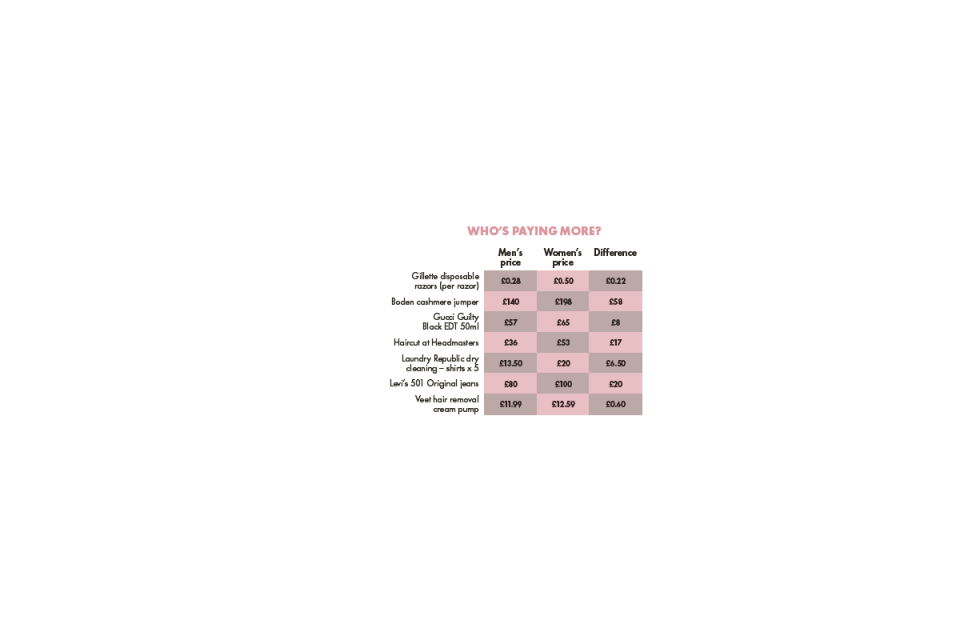The Pink Tax: what you need to know

Since moving in with my partner, I’ve become starkly aware of the differences in the prices of the products that we buy. When we do our weekly shop together and he reaches for razor heads, I can’t help but think, ‘Why am I paying more for mine?’ We’re not just talking about the non-negotiable feminine products I buy each month either; everything from perfume to clothing, there is still so much that is more expensive.
The Pink Tax, as this phenomenon is known, has been around for years and manufacturers tend to justify it by saying female products have more expensive formulas, fancier packaging and more complex fragrances than male alternatives. But can this always be the case? Conversations around gender and how people choose to identify are now happening everywhere and, as traditional gender roles are being re-evaluated, so too is the existence of such an unfair and hidden tax. Products that have been typically gendered in the past are becoming unisex, with brands such as Gender Free World selling genderless clothing and Rihanna’s beauty brand, Fenty Beauty, adopting a more gender-neutral approach.
So why does it matter so much? Charging more for women’s products gives women less buying power. The knock-on effect is that we have less to save for the future, which, added to the fact women earn less over their lifetimes, were more affected financially by the pandemic and have less in their pension pots, culminates in further economic inequality.
Comparing costs
We looked at randomly selected products*, comparing the prices of items that are targeted at women to those for men. While some formulas – such as skincare – can make it hard to compare like for like, we’ve focused on products that are as near to identical as possible.

The Pink Tax
Our findings show that some products across a range of categories, from clothing to personal care, are still 32% more expensive for women, with the total price difference being £110.32. Usually, the difference in price was obvious, but some products, such as razors, are sold in smaller multi-packs that give less value for money than the equivalent product for men.
Whatever the product, it’s important to remember that prices in store are set by the retailer, so it’s worth shopping around and if, as a consumer, you feel the men’s nearest equivalent product offers what you need at better value, then vote with your wallet. Otherwise, assuming you buy all the products we looked at once a year for the rest of your life, you’ll be spending £6,729.52** more than men on these over a lifetime.

Beat the system
While products aimed at women aren’t necessarily pink anymore, advertisers are still using purpose-driven marketing to appeal to us and charging us more for them. “Women tend to be broad-based in values, putting social justice and equality high on the agenda,” explains Kelly Hearn, psychotherapist and co-founder of Examined Life. “Marketers know this and advertise accordingly, making women feel strong and empowered by associating those feelings with whatever product they want them to buy. Before you buy anything, enforce a “pause before purchase” moment,” says Kelly. “Take a moment to ask yourself a few questions: Why am I buying this? Is it out of emotional need or something that will bring me genuine value?”
Also, rather than automatically reaching for products targeted at you, consider all the options available. Nowadays, I opt for the same type and brand of razor that my partner does and we bulk-buy razor heads together. If it’s a perfume, and you prefer the scent that’s ‘for men’, then buy that. Look for cheaper skincare by identifying the ingredients your skin needs (such as vitamin C) and searching for serums and creams that include it, even if they are aimed at men.

At hairdressers, having different costs for similar men and women’s services is slowly changing. While some national chains, such as Headmasters and Rush, still quote prices according to gender, not all do. “Historically, hairdressing was a highly segregated market with “ladies salons” and barber shops offering very different services,” explains Sarah Brass, director at Taylor Taylor London. “As men became more comfortable using cosmetic products and experimenting with different hair styles, those boundaries began to break down rapidly,” she says. So, when the time comes for a haircut, it’s worth trying to negotiate with your hairdresser if you have shorter hair or want a simpler service. “It’s all about the finish,” says Sarah. “A short, technical cut can take just as long to create as a longer, layered style, but where the difference will be most noticeable is in the finishing time. That’s why at Taylor Taylor we charge for the actual service in the salon, rather than differentiating our prices by gender.”
Most importantly, call out companies when you see blatantly gendered products. You can do this by emailing them or taking to social media to make your feelings known. From plastic-free packaging to vegan food, we’ve seen the effect consumer pressure can have. Manufacturers and retailers will only change if they think there’s an appetite for it, so make your voice heard and complain about the Pink Tax wherever you see it.
What are you paying for your period?
The Tampon Tax, which saw period products being taxed as luxury goods, was abolished from 1 January 2021, meaning period items are now 5% cheaper.
Yet, menstruating, which people obviously have no control over, still remains expensive, with research*** finding that period products could cost you £2,625 over a lifetime. Campaign groups like Free Periods and Bloody Good Period are looking to find ways to make period products cheaper or free, especially for those experiencing period poverty. Looking to cut costs? Try the following:
Swap from branded products to supermarket own brands.
Use a period comparison site (yes, really!), such as Sanitary Saver.
Make the change to reusables. After the initial cost, menstrual cups can be used for up to 10 years, while reusable pads can last for up to five years.
Download a cycle-tracking app like Flo or Clue so you’ll know when your period is due and can shop around for cheaper products in advance.
SOURCES:
*PRODUCTS SOURCED BETWEEN 30 MARCH AND 19 APRIL 2021. ALL PRICES TAKEN FROM MANUFACTURER’S WEBSITES OR RECOMMENDED RETAILERS.
**CALCULATION ASSUMES WOMEN SPEND £110.32 MORE THAN MEN ON THESE PRODUCTS AYEAR BETWEEN 20 TO 81 YEARS OLD.
***MONEYSAVINGEXPERT.
RIGHT TO REPLY
Red gave all retailers used in this piece a right to reply. Accounting for the retailers which replied to our request for comment, here is what they told us:
Headmasters: “"At Headmasters we continually assess the needs of both the market and our clients in this ever-evolving industry. At present our pricing model, works well with our current client base, however, the discussion as to how to evolve our service offering as times change is never off the table and this is a subject that is definitely being discussed across the industry as a whole.” Creative & Communications Director, Andrew Barton.
Gucci: “The recommended retail price of every fragrance we create and manufacture is based on the specific characteristics of that unique product. The final price at which the product is sold to the consumer is set by the retailer, as per standard practice in the UK and EU.” Gucci Spokesperson.
Gillette: “Across our business, we don’t believe in pricing differences based on gender – and we’re committed to recommended retail pricing (RRPs) that follows this. However, this doesn’t mean all our products will have the same price. For example, Simply Venus 2 has a pivoting razor head whereas Gillette Blue II has a fixed head. A pivoting head gives a better, more comfortable and close shave, as it’s designed to better hug the contours of the body.
We offer a range of products to suit the needs and preferences of men and women which have a different range of benefits, and therefore a range of RRPs. It’s the same as what you might see in other categories, like clothes for example. A jumper fulfils the same basic need for both men and women (just as a razor does) but that doesn’t mean the price point will be the same - it depends on the style, the cut and the materials used. If either the male or female jumper has more of these and is priced more, it’s not a gender tax, it’s because it’s fundamentally developed to be different.
Our products are different because men and women are different and they have different in-use needs when it comes to shaving. They have different anatomies, use our products on different body parts, and in different environments. Therefore there is a distinct difference between brands and variants. Our focus is to ensure that any pricing differences are driven by non-gender based factors such as product features and benefits, materials costs, manufacturing variances, promotional factors and more.” Gillette Spokesperson.
The following response comes from Laundry Republic’s website: ‘Industry standard pressing machines are designed for men’s shirts. Women’s shirts and blouses, which can differ in both size and design, can’t be pressed on these machines, so they must be pressed by hand, which is why they cost a bit more.’
Subscribe to Red now to get the magazine delivered to your door. Like this article? Sign up to our newsletter to get more articles like this delivered straight to your inbox.
You Might Also Like

 Yahoo Finance
Yahoo Finance 
